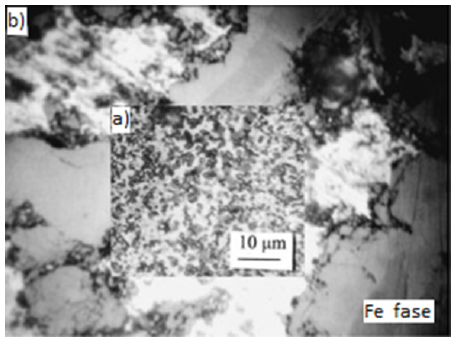- Submissions

Full Text
Research & Development in Material Science
Ideas for Changing the Microstructure and Properties of Aluminum Alloys
Anna Petrova1*, Svetlana Yaneva2 and Nikolay Stoichev1
1Department of Space Material Science Space Research and Technology Institute, Bulgarian Academy of Sciences, Sofia, Bulgaria
2Institute of Metal Science, Equipment and Technologies with Hydro- and Aerodynamics Centre “Acad. A. Balevski”, Bulgarian Academy of Sciences, Sofia, Bulgaria
*Corresponding author:Anna Petrova, Department of Space Material Science, Space Research and Technology Institute, Bulgarian Academy of Sciences, Sofia, Bulgaria
Submission: June 23, 2022;Published: July 11, 2022

ISSN: 2576-8840 Volume 17 Issue 3
Short Communication
Scope of the problem
Aluminum is a silvery-white metal of the third group of the Periodic Table of the Elements. It is obtained in large quantities for use in various industrial purposes. As a structural material, aluminum has mediocre mechanical properties, which is overcome by alloying with various metals. Pure aluminum is used much less than its alloys. Aluminum alloys are obtained by alloying aluminum with various other metals, the so-called. alloying elements. Common alloying elements include boron, iron, silicon, magnesium, manganese, copper, nickel, lead, titanium, chromium, zinc, zirconium, lithium, scandium, silver and others. Today, more than 100 types of aluminum alloys are used in industry. Manufacturers are constantly improving their production processes to increase product quality while minimizing costs and environmental impact. One important property of aluminum is that it retains its properties after processing, which means that aluminum products can be recycled into new products [1]. This helps save the amount of energy that must be used to produce primary aluminum. The International Aluminum Institute (IAI) estimates that billions of tons of aluminum have been produced worldwide since 1880, three-quarters of which is still used today. About 35% is used in building construction, in the form of electrical cables - 30% and in transport - 30% [2]. Aluminum has risen by 48% since the beginning of this year amid growing demand and difficulties in delivery.
The aim of our research is to analyze the influence of the composition and microstructure of alloys obtained in extreme conditions on the properties of the products with the help of model alloys (in relatively small volumes).
Conditions in outer space are a major challenge for the processing of aluminum alloys [3]. During the flight of the second Bulgarian cosmonaut, flight (Soyuz TM-5, comparative experiments were conducted on earth and in space. These experiments showed that with increasing iron conatent in the alloys between different eutectic colonies appear metallographically detectable large iron particle especially in microgravity.
The addition of other metals to aluminum leads to the production of alloys with a homogeneous microstructure, which provides the necessary mechanical properties of the alloys. With the precise manipulation of key metallurgical factors, new alloys and products are created [1,4]. Technologies are being introduced that accelerate the process of hardening alloys and expand the methods and types of product production. The solidification speeds of the melts reach 103- 06K/s.
When studying the intermetallic phases of alloys obtained on earth (Figure 1a) and in space (Figure 1b), their size and shape can be estimated. This data has shown the need to introduce new technologies that are already part of the global processing of aluminum alloys [3,5]. The technologies for flat flow casting “Planar Flow Casting” were introduced and е achieve cooling of the melts at a rate of R=10-3-6K/s.
Figure 1: Needle-like iron containing in: a) Sample of Al-Si alloys; b) Space sample of Al-Si alloys.

By rapid curing of such melts, composite nano-microcrystalline strips or powders with unique properties are obtained. For the needs of the practice, these bulk materials are compacted by hot extrusion to obtain massive samples with unique properties such as Al alloys, with microhardness characteristic of bainitic structures in carbon steels (50-56 HRC).
With proper process of atomization and subsequent extrusion, the improvement of the microstructure and properties of the obtained alloys is impressive (Figure 2). This is the basis of the rapid development of nano-microcrystalline alloys.
Figure 2:Microstructure of the Al-Si alloy: a) The microstructure of the final product after extrusion; b) The large particles of the initial alloy before extrusion.

References
- Schimbäck D, Mair P, Bärtl M, Palm F, Leichtfried G, et al. (2022) Alloy design strategy for microstructural-tailored scandium-modified aluminium alloys for additive manufacturing. Scripta Materialia 207: 114277.
- https://international-aluminium.org/
- Stoichev N, Yaneva S, Regel L, Safonova I (1990) International Journal for Microgravity Research and Applications. 4(4).
- Kirkova E (2007) Chemistry of the elements and their compounds, University Publishing House “ Kliment Ohridski”, ISBN: 9789540735047:692.
- Blakey-Milner B, Gradl P, Snedden G, Brooks M, Pitot J, et al. (2021) Metal additive manufacturing in aerospace: A review. Materials & Design 209: 110008.
© 2022 Anna Petrova. This is an open access article distributed under the terms of the Creative Commons Attribution License , which permits unrestricted use, distribution, and build upon your work non-commercially.
 a Creative Commons Attribution 4.0 International License. Based on a work at www.crimsonpublishers.com.
Best viewed in
a Creative Commons Attribution 4.0 International License. Based on a work at www.crimsonpublishers.com.
Best viewed in 







.jpg)






























 Editorial Board Registrations
Editorial Board Registrations Submit your Article
Submit your Article Refer a Friend
Refer a Friend Advertise With Us
Advertise With Us
.jpg)






.jpg)














.bmp)
.jpg)
.png)
.jpg)










.jpg)






.png)

.png)



.png)






